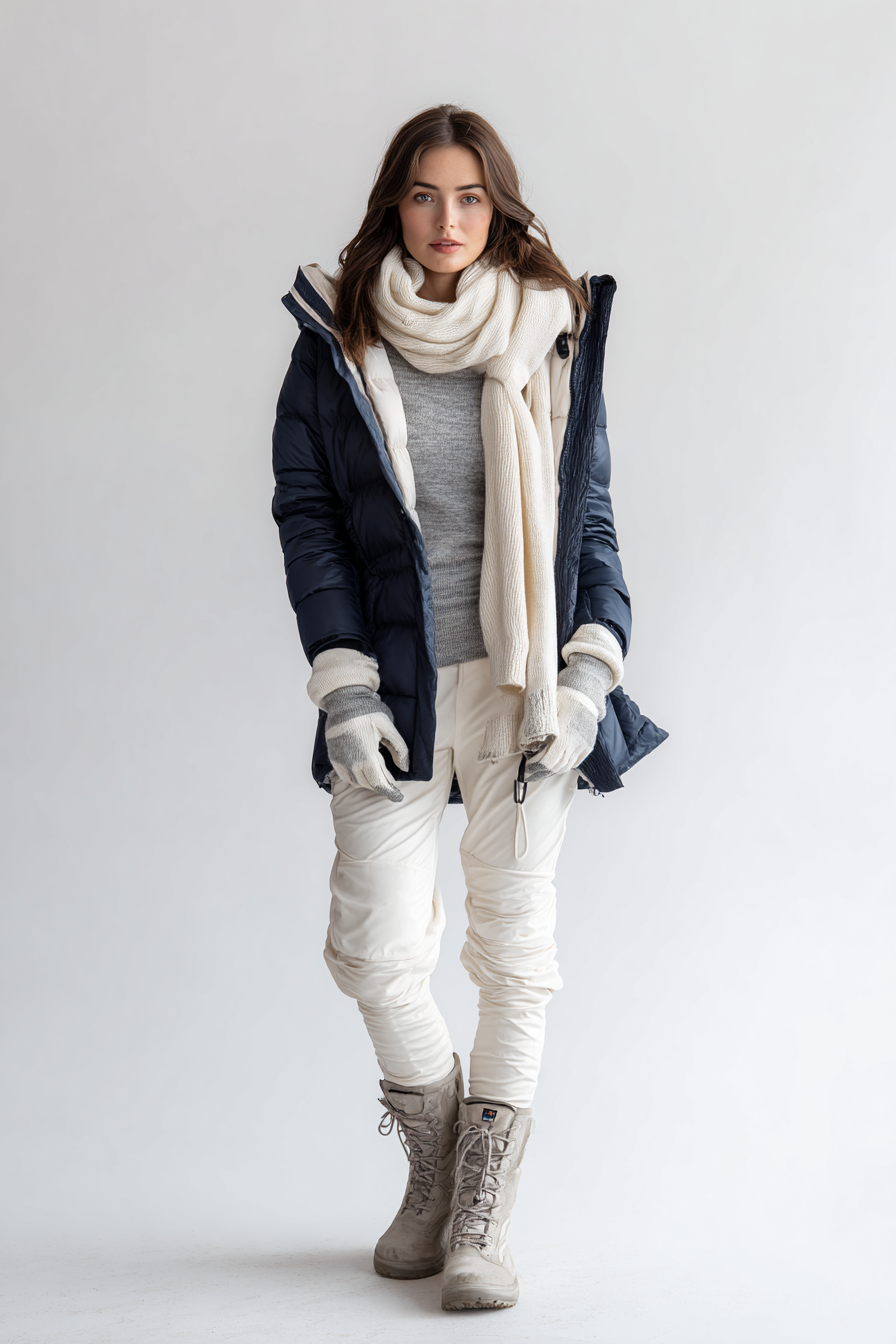Dressing well for winter begins with strategy, not bulk.
The goal is comfort that lasts through chores, errands, and time outdoors.
Layering makes this possible.
When each piece has a purpose – managing moisture, holding warmth, or blocking weather – you stay steady and at ease in the cold.
In practice, my system is simple: a merino wool base layer to keep skin dry, a fleece or boiled wool midlayer to trap heat, and a weatherproof outer layer to shield against wind and snow. These three steps form a reliable framework.
With them, you can approach winter with confidence, knowing your clothing is working with your body to keep you warm and comfortable.
The Science of Staying Warm
Your body is already the heat source.
Every movement and breath generates warmth, and the role of clothing is simply to hold that warmth in place.
Layering works by creating a system: the base layer moves moisture away, the midlayer traps heat, and the outer layer shields from wind and weather.
Moisture control makes all the difference. When sweat lingers, it cools too quickly.
A fabric like merino wool keeps skin dry so your body can regulate itself with ease. With insulation and protection added on top, the system stays balanced.
The encouraging part is simple: your own body provides enough warmth.
With the right layers, you don’t fight the cold – you let your clothing support what your body is already doing naturally.
The Three-Layer System (Basics)
Layering for winter works best when you keep it simple. Three layers are all you need, and each one has its own job.
When you put them together, you get a system that’s easy to adjust and reliable no matter how the day changes.
1. The Base Layer
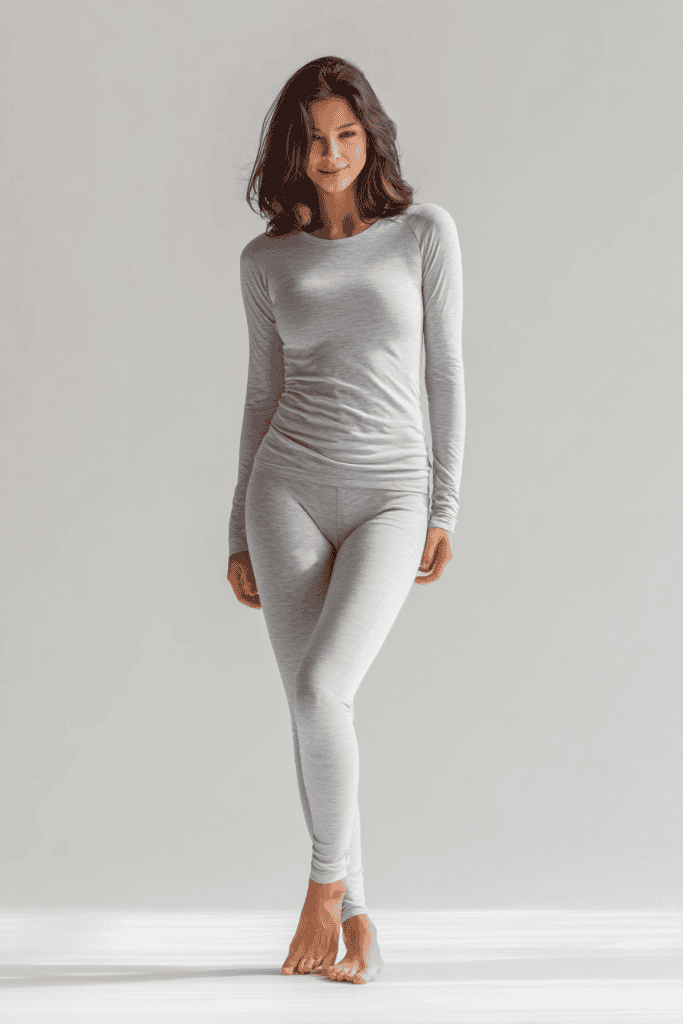
The base layer is your foundation. Its job is simple but vital – keep your skin dry and comfortable.
When the first layer does its work well, the rest of your clothing can perform as it should.
Merino wool is my choice for this step. It’s lightweight, breathable, and naturally wicks away moisture.
Unlike bulky fabrics, it sits close to the skin without feeling restrictive, creating a steady comfort that lasts through both movement and rest.
A well-fitted merino top and leggings form a reliable base for winter days.
In milder weather, you may only need a long-sleeve shirt or lightweight thermal.
The key is consistency: start with a fabric that helps your body regulate itself, and every layer that follows will work more effectively.
2. The Midlayer

The midlayer holds warmth in place. Its role is to trap the heat your body produces while still allowing air to circulate.
This is where insulation happens – not from heavy bulk, but from choosing the right material.
I often turn to fleece or boiled wool for this layer. Fleece is light, flexible, and easy to move in – perfect for chores or active days outside.
Boiled wool, by contrast, is denser and naturally wind-resistant, making it dependable for colder, still conditions.
Both provide warmth without weighing you down. Think of the midlayer as your adjustable piece.
On milder days, a fleece pullover may be all you need. In deeper cold, a boiled wool sweater or vest adds steady insulation.
With this layer chosen well, your clothing system adapts easily to changing conditions.
3. The Outer Layer

The outer layer is your shield. Its job is to block wind, snow, and rain so the inner layers can do their work.
Without it, even the best base and midlayers can lose effectiveness in harsh conditions.
A weatherproof coat or shell is the piece I rely on.
It should be breathable enough to let moisture escape, yet strong enough to stop cold air and dampness from getting in.
Look for designs that allow free movement, with a length that covers your core and durable fabric that holds up to daily use.
This layer doesn’t have to be the heaviest item in your closet – it just needs to be dependable.
When chosen well, it completes the system: base layer to manage moisture, midlayer to hold warmth, and outer layer to protect.
Together, they form a practical framework that keeps you steady and comfortable through winter’s demands.
Accessories That Count as Layers
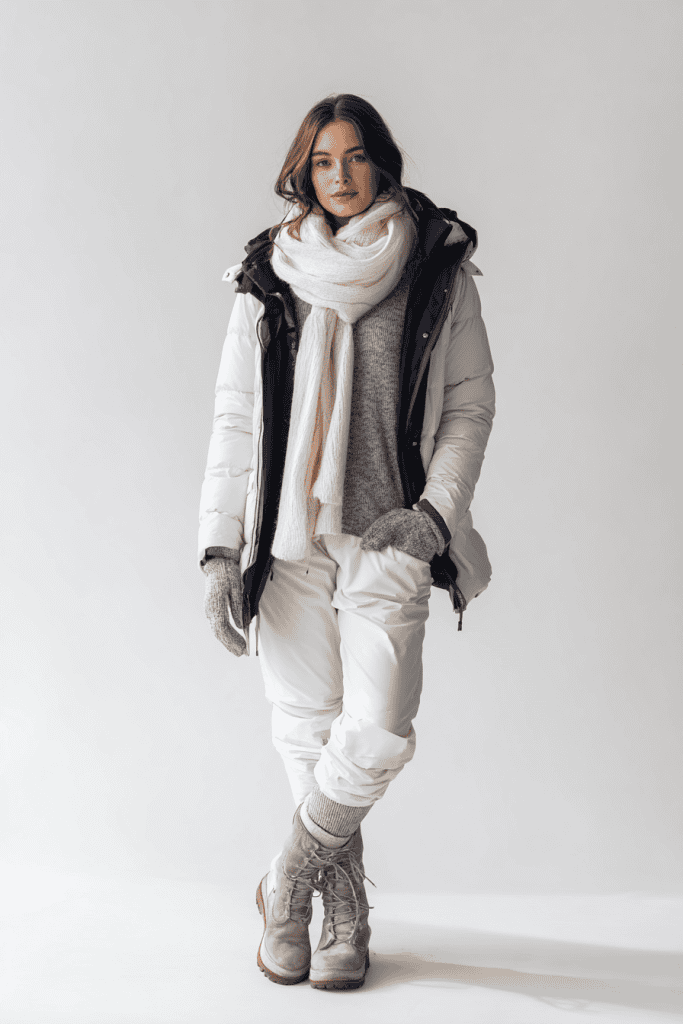
Clothing layers work best when they extend beyond your torso.
Accessories often make the difference between staying comfortable and losing heat too quickly.
Each one plays a role in protecting the body’s most vulnerable areas.
- Hats and Headbands: A wool or fleece-lined hat keeps steady warmth where you need it most. Headbands work well on milder days, covering ears without bulk.
- Gloves and Mittens: Start with a thin liner glove for dexterity, then add a weatherproof mitten or insulated glove on top. This layered approach keeps hands warm while allowing flexibility.
- Scarves and Neck Gaiters: A scarf or gaiter seals gaps at the neck, an area where heat often escapes. They’re also easy to remove if you warm up.
- Socks and Footwear: Merino wool socks hold warmth while moving moisture away. Pair them with insulated, weather-resistant boots for lasting comfort.
Accessories complete the system by addressing the places most prone to heat loss.
With them, your layering strategy is balanced from head to toe.
Everyday Layering Strategies

The strength of layering is its flexibility.
Once you understand the system, you can adjust it to fit your day instead of dressing the same way for every situation.
- Outdoor chores: For steady tasks like hauling wood or tending animals, start with merino wool at the base, add a boiled wool sweater for insulation, and finish with a weatherproof coat. This combination keeps warmth steady, even when you’re outside for long stretches.
- Indoor work: If much of your day is spent inside, a light merino base with a fleece midlayer is usually enough. Keep your outer shell nearby for trips outdoors.
- Errands and travel: Balance warmth with ease of movement – a merino base, fleece jacket, and weatherproof shell give comfort while looking neat enough for town.
- Active outdoor work: For shoveling, walking, or other physical activity, lighten the middle layer. A merino base, a thinner fleece, and a breathable shell prevent overheating while still keeping you protected.
The more you practice adjusting, the more natural it becomes. Layering is a set of tools you can shift as your day and weather change.
Practical and Sustainable Clothing Choices for Winter Layers
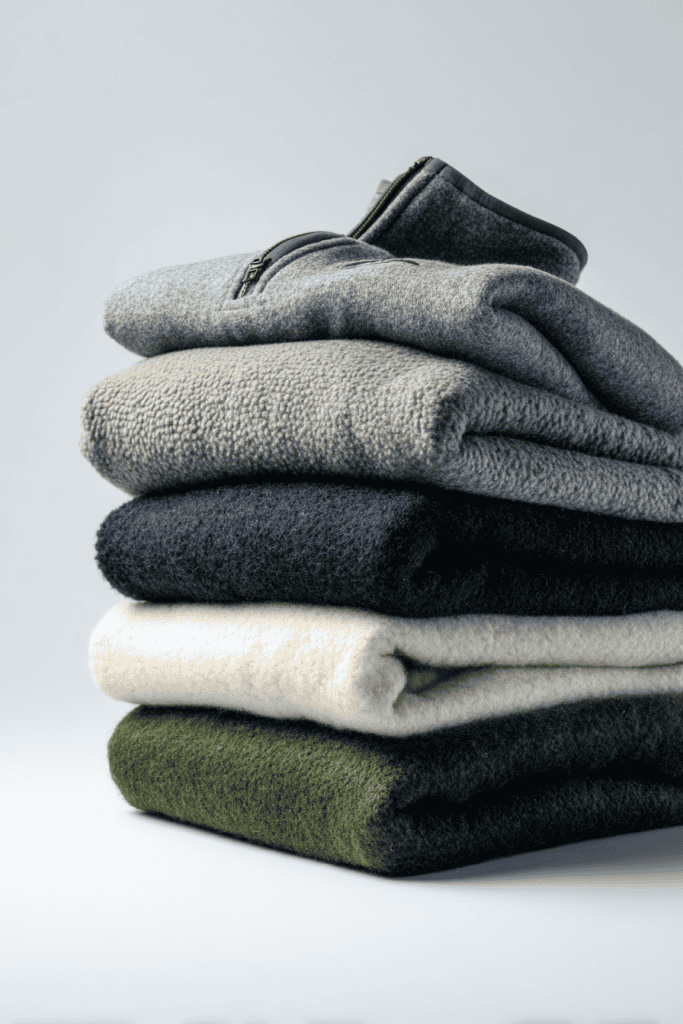
A strong layering system depends on materials that work with you, not against you.
Natural fibers such as merino wool and boiled wool excel here: they hold warmth, manage moisture, and remain comfortable through repeated wear.
With fabrics that perform consistently, fewer layers are needed to stay warm.
Choosing quality also brings longevity.
A well-constructed coat, a dependable sweater, or a pair of merino base layers can serve for years when cared for properly.
Simple habits (air-drying wool, brushing boiled wool to refresh it, or reproofing a shell once a season) keep these pieces ready for steady use.
This approach is practical and sustainable.
Instead of a large collection, a small set of purposeful garments provides both reliability and comfort, winter after winter.
Smart Layering Tips for Better Comfort
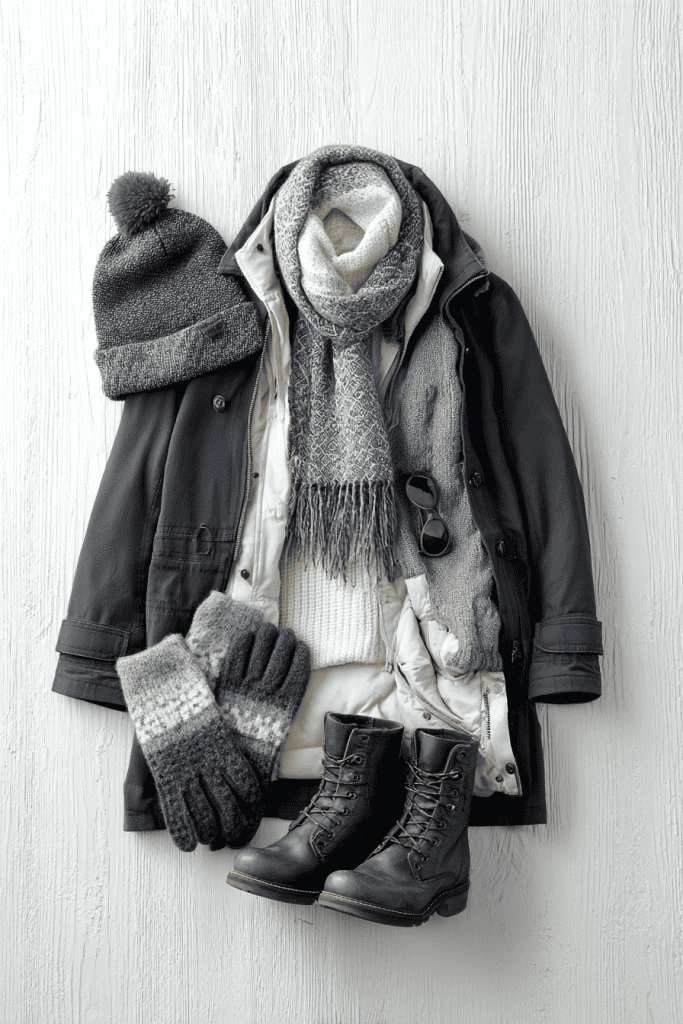
A few mindful choices can make the difference between simply dressing for the cold and feeling steadily comfortable all day.
Choose the Right Weight, Not Extra Bulk
Adding too many layers often makes movement harder. Instead of piling on clothing, select materials that provide insulation without heaviness.
For example, one boiled wool sweater traps more heat than two cotton sweatshirts combined.
Aim for fabrics with high warmth-to-weight ratios, such as merino wool or fleece, so you stay warm while still able to bend, lift, and work outdoors.
Prioritize Breathability
A layering system that doesn’t breathe can trap sweat, leaving you uncomfortable.
A merino base layer naturally wicks away moisture, while a vented outer shell allows excess heat to escape.
This balance prevents overheating during physical activity like shoveling snow, yet still protects you when you pause to rest.
Look for coats with pit zips, side vents, or adjustable cuffs to release heat quickly without removing a layer.
Cover the Extremities
Much of your body’s heat escapes through the head, hands, and feet. Addressing these areas completes the system:
- Head: A wool beanie or fleece-lined hat provides steady insulation. For milder days, a headband keeps ears warm without adding bulk.
- Hands: Layering works here too. Thin liner gloves give dexterity, while insulated mittens or weatherproof gloves add protection.
- Feet: Wool socks regulate temperature and wick away moisture. If you spend long hours outdoors, consider wearing a thin liner sock under a thicker wool pair inside insulated boots.
Adjust as Conditions Change
Layering is meant to be flexible. Cold mornings may call for a boiled wool sweater under your coat, but by midday you might only need a fleece.
Keep removable items like a vest or scarf close at hand so you can respond quickly to shifts in weather or activity.
For active tasks, lighten the midlayer; for still tasks, add insulation. The goal is steady comfort without constant overheating or chilling.
Seasonal Adaptations for Winter Layering
Winter is never one single temperature. Adjusting your layers to match the season’s shifts keeps you comfortable and ready for any task.
- Early winter: A merino base, light fleece, and breathable shell are usually enough. Add a scarf or light hat as needed.
- Deep cold: Trade the light fleece for boiled wool or add a vest for stronger insulation. A heavier coat with wind protection keeps the system steady outdoors.
- Wet or damp days: A waterproof outer shell is essential. Paired with merino underneath, it keeps you dry and warm.
- Variable weather: For mornings that warm by midday, rely on thinner pieces that can be added or removed easily.
With a few small adjustments, your core system carries you through the full season – early chill, deep freeze, and everything in between.
Example Layering Systems

A simple set of core pieces can be combined in different ways to meet the day’s conditions. Here are a few reliable combinations:
- Chores in freezing temperatures: Merino wool base, boiled wool sweater, and a weatherproof coat. Add wool socks, mittens, and a hat for complete coverage.
- Errands in town: Merino base, fleece jacket, and a lighter shell. This balance keeps you warm outdoors while remaining comfortable indoors.
- Active outdoor work: Merino base, lightweight fleece, and a breathable shell. This combination prevents overheating while still keeping you protected.
- Mild winter days: A merino base with a vest or light fleece is often enough. Keep a shell close for unexpected wind or weather.
These examples show how a few well-chosen layers adapt easily.
By starting with merino, adding insulation as needed, and finishing with a weatherproof shell, you stay comfortable through almost any winter setting.
Build Confidence With Smart Winter Layering
Layering well is a skill that makes winter straightforward.
Begin with merino wool for a steady base, add fleece or boiled wool for insulation, and finish with a weatherproof coat.
Support your system with the right accessories, and you’ll move through the season prepared for both daily tasks and unexpected changes in weather.
The framework is simple, adaptable, and effective. With just a few dependable pieces, you can build comfort and confidence into every winter day.
What’s your go-to layering piece in winter? Share your tips in the comments below.
FAQs
1. Can I use cotton as a base layer in winter?
Cotton is best avoided for the base layer because it holds moisture instead of moving it away. For steady warmth, choose merino wool or another breathable fiber that wicks sweat and keeps skin dry.
2. How many layers are usually enough for everyday winter wear?
For most conditions, three layers work well: a base, a midlayer, and an outer shell. You can adjust by removing or adding accessories depending on the temperature and your activity level.
3. What’s the difference between fleece and boiled wool?
Fleece is lightweight, quick-drying, and flexible, which makes it great for active use. Boiled wool is heavier, naturally wind-resistant, and holds heat more steadily. Think of fleece for movement and boiled wool for still or colder conditions.
4. How do I keep my layering system comfortable indoors and outdoors?
Choose breathable layers that let your body regulate heat. A base and light midlayer work indoors; keep your outer shell handy to slip on when heading outside.
5. How should I care for winter layers so they last?
Wash merino wool gently and let it air-dry, brush boiled wool to refresh the fibers, and treat outer shells with a seasonal water-repellent spray. Small habits like these keep your pieces durable and ready for winter year after year.

